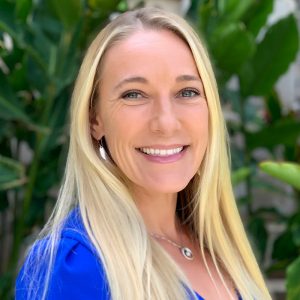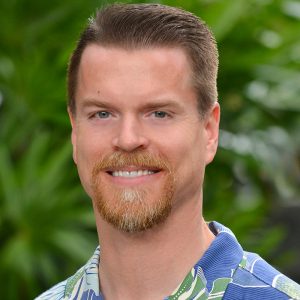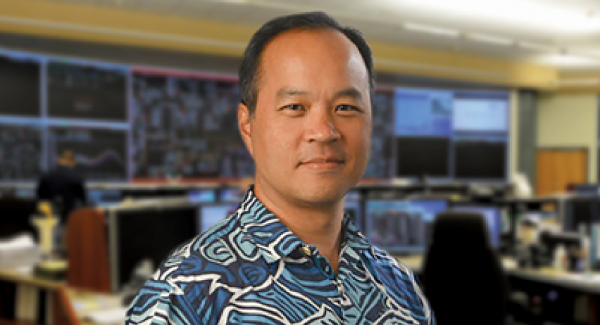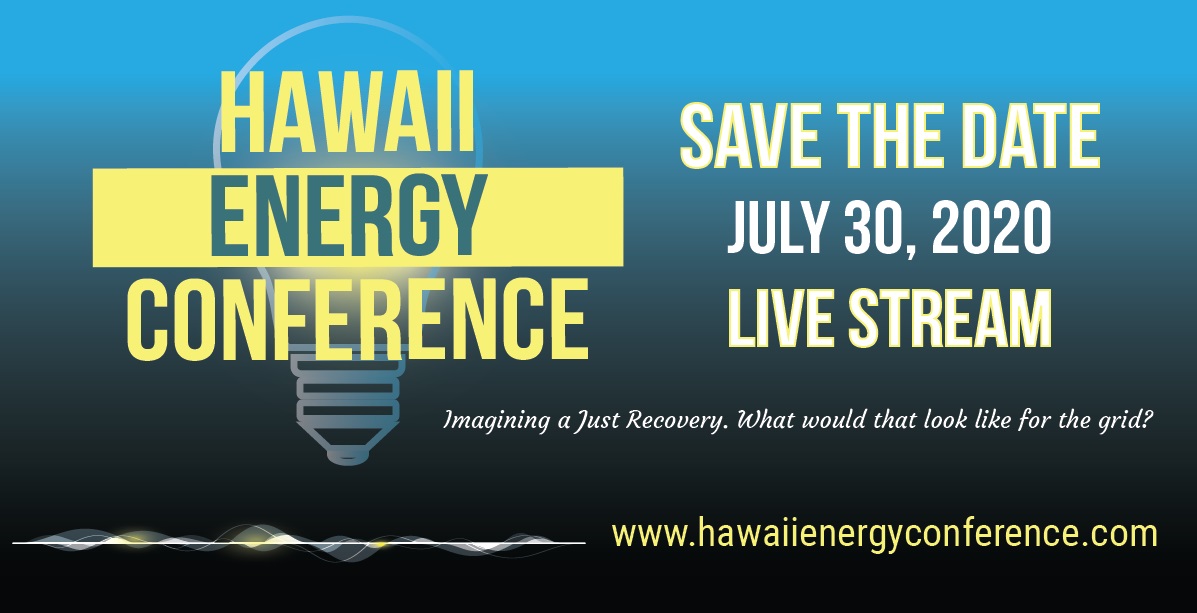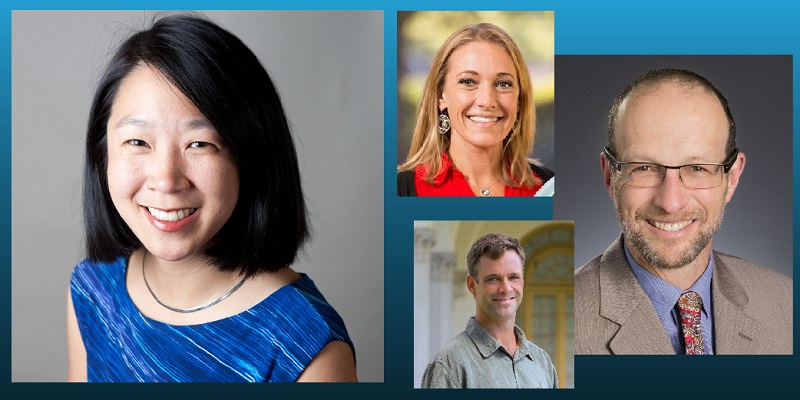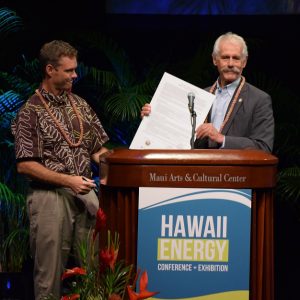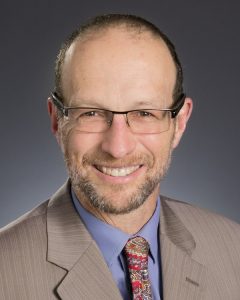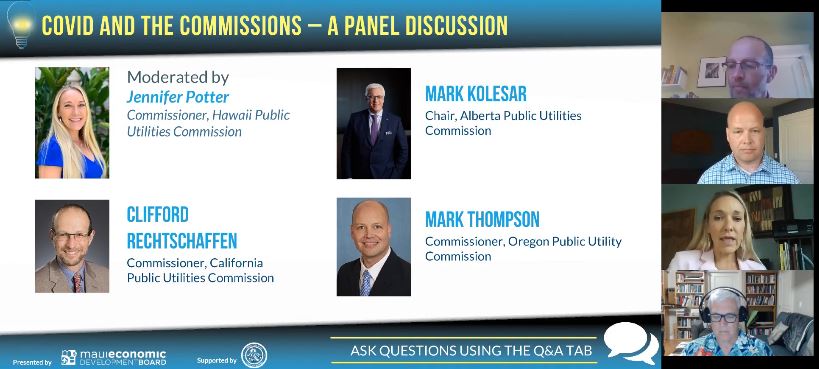
Highlights of the 2020 Hawaii Energy Conference
The 2020 Hawaii Energy Conference (HEC), postponed in March due to Covid-19, aired in July as a live-stream online event. One of the nation’s leading energy conferences, HEC brought together professionals on energy policy, strategies, leadership, and innovation to focus on how the energy sector should respond to the challenges imposed by the pandemic.
Presented by the Maui Economic Development Board (MEDB) and supported by the Mayor’s Office of Economic Development, the virtual conference explored the theme Imagining a Just Recovery: What would that look like for the Grid? The free event included industry experts discussing how the energy sector can and should respond to our current challenges by creating a ‘just’ electrical grid.
“With HEC going virtual, it attracted a bigger and broader audience than its traditional base of energy industry leaders from Hawaii, Continental U.S., Japan, and Europe,” said Leslie Wilkins, MEDB President and CEO. “The conference welcomed over 600 participants from 24 different states and Puerto Rico. An exciting feature this year was our international participation. Six countries joined us, spanning time zones from Europe to Asia.”
The program included four panels plus brief video presentations with information related to the theme. Hawaii Clean Power Alliance presented The Macroeconomics of Change and Ulupono Initiative’s video presentation was on Why We Should All be Talking More About Performance Based Regulation.
“The HEC provides a vital service to our state by convening policy-makers and stakeholders to discuss our energy future,” said Murray Clay, President of Ulupono Initiative. “As we all work together to help Hawaii stabilize and recover from the Covid-19 pandemic, it is especially important to embrace innovative technology, policies and regulation within the renewable energy sector, which will help protect our natural environment, shielding our island state from volatile world fossil fuel markets, strengthening its overall resilience, and aid in its economic recovery.”
Given the importance of these issues across the globe, HEC recognized that Covid-19 has laid bare the stark reality of pre-existing inequalities in society. The elderly, the poor, and minorities have suffered tremendously in the pandemic’s wake. An equitable or ‘just’ recovery is the only path forward to heal communities. Participants discussed what strategies policymakers and regulators will use to achieve results that benefit broad sectors of society. Also, how will utilities and companies in the energy sector contribute?
KEYNOTE: SCOTT SEU
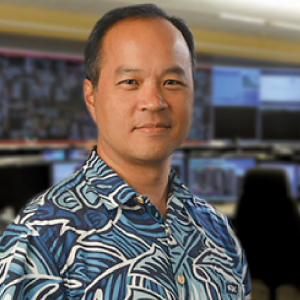
Scott Seu
President & CEO, Hawaiian Electric Company
In his keynote, Why Energy Equity Matters, Especially to the Electric Company, Scott Seu, President and CEO of Hawaiian Electric Company explained, “Fairly serving all customers is essential to how we run our programs and offer just and reasonable rates. As we transform our energy system to one that is decarbonized, decentralized, and more resilient, the elements of equity, opportunity, and participation are as important as any field source or technology for our successful transition to renewable energy. Working our way through this crisis, I challenge our Hawaiian Electric team to lead with empathy and to consider the level of anxiety and even hopelessness that a lot of people are experiencing.”
Seu continued, “It is not enough anymore to simply say we will all benefit from cleaner, cheaper renewables someday. The duration and the depth of our current economic downturn is unlike anything we have ever experienced; so someday is not soon enough. The leaders of Hawaiian Electric are looking at what bold strategies we can use to benefit the most people, the most quickly.”
Seu added, “The renewable energy transformation must include everyone. That is what equity looks like to me. Then, no one gets left behind. Working our way through this crisis, I have challenged myself and our team to think outside our traditional role of keeping the lights on; to be bold, creative, and come up with ideas, such as a community solar program, that will strengthen our economy; to be the better Hawaii we can all imagine.”
PANEL 1: COVID and the Commissions
This panel provided a comprehensive overview of how four state Commissions have been tackling the response to Covid in their jurisdiction.
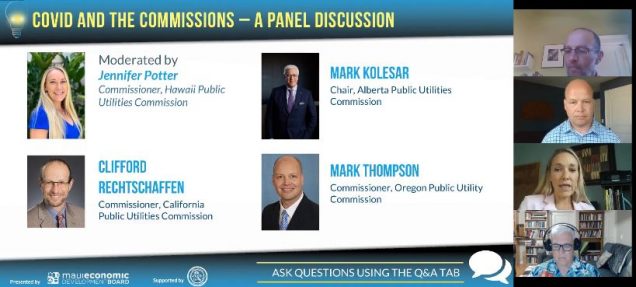 MODERATOR: Jennifer Potter, Commissioner, Hawaii Public Utility Utilities Commission
MODERATOR: Jennifer Potter, Commissioner, Hawaii Public Utility Utilities Commission
Clifford Rechtschaffen, Commissioner, California Public Utilities Commission
Mark Kolesar, Former Chair, Alberta Public Utilities Commission
Mark Thompson, Commissioner, Oregon Public Utility Commission
Commissioner Potter stated, “The Commissioners represent states that have displayed innovation in their approach to keeping the utility services intact, addressing affordability during the pandemic, and strategies to evolve the regulatory stakeholder processes to accommodate remote participation. The HEC has regrouped at a critical time for Hawaii and our country. The incredible macroeconomic stress and individual financial burdens across our nation mean that there is no better time to have dialogue on affordability and equity. Building a recovery plan that includes all socioeconomic groups is imperative.”
Commissioner Rechtschaffen commented, “California signed a Memorandum of Understanding with five other states and Hawaii to fight climate change. We look forward to proceeding with these joint efforts. We have all been dealing with serious challenges since millions of people are out of work. In California, our immediate focus when the virus hit was to make emergency measures for residential and small business customers, including a moratorium on disconnections and mandatory payment plan options. We have also worked to expand our bill-payer subsidy program for our low-income customers. We have mandated that utilities engage in extended outreach and have prevented them from removing people from any programs.”
Rechtschaffen continued, “Covid-19 is a call to address equity in all our programs as we go forward. It has also affected the utilities in incredibly significant ways. The under-collections will be in the millions. How can we recover the lost costs? Also, our Commission has had to advance in online technology, having to use virtual for all meetings. Public participation and workshops are virtual. We have had webinars with 400-500 people participating, and are engaged with transparency in the community.”
Former Chair Kolesar observed, “Alberta is a complex market and regulatory regime. Since 1996, Alberta has operated Canada’s only truly competitive wholesale electricity market through which all electricity, whether generated in Alberta or imported into the province, is bought, and sold. We as a province have low oil prices, which has an economic impact. So, what we have is a decline in demand. Wind and solar came on when the pandemic hit.”
Kolesar continued, “The utilities are supporting their own customers by providing opportunities for them to change the way they pay their bills. It became pretty clear that the utilities do have an incentive to keep as many customers on and support them. On the large industrial and commercial side there was a lot of concern about the lack of short-term rate relief. I think that most of that centered around demand changes. If a business has to stay open with no revenue—that is a big concern, not yet resolved.”
Kolesar added, “Long term, there will be a significant revenue short-fall for a lot of the utilities here. I do not know how big that currently is, but it is a major and complex issue. There are a lot of questions around reduction in demand, revenues and costs incurred. For example, how do the utilities recover, and how much is there to recover?”
Commissioner Thompson expressed, “In the midst of other important events, the scope of our efforts is also to remodel social equity issues. We changed late fees to make the procedure easier, more inclusive, and efficient for customers to follow than in the past. We have created an internal group to reach out to stakeholders and social justice organizations with the goal to work holistically on these issues as we try to be responsive to their needs. We have had public meetings and workshops with different groups, and I can say that the scope of the work is that everything is on the table with a list of ideas to bring relief to all the stakeholders.”
Thompson concluded, “As a new Commissioner I have felt that this is the most meaningful work because the issues are key and the need is great. The way forward is not yet clear, but it is a chance to do good for all parties involved in a situation that is serious.”
PANEL 2: Solar Jobs—Being Part of the Solution?
This panel discussed how jobs in solar and other parts of the clean energy sector can contribute to a ‘Just Recovery’.
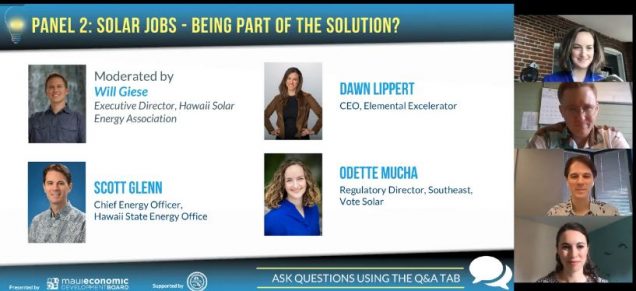
Moderated by Will Giese, Executive Director, Hawaii Solar Energy Association
Scott Glenn, Chief Energy Officer, Hawaii State Energy Office
Dawn Lippert, CEO, Elemental Excelerator
Odette Mucha, Regulatory Director, Southeast, Vote Solar
Giese commented, “The Hawaii Solar Energy Association represents about 90 percent of the local solar contracting development in Hawaii. Across the world, Covid has shocked the system. In Hawaii, where our economy is primarily based on tourism, it is just not happening now, and we are seeing the impacts of it. I have been thinking about what Hawaii will look like in the next year or two. If we build an economy based on clean-energy jobs, what are the steps that we have to take to get there? Additionally, what steps do we need to take to get to the economy that we would all like to see? A good equity question is how do you get involved in a new industry and get the jobs into the community?”
Lippert observed, “I think large structural change is a really important piece of it. To recognize, as we talk about equity in particular, that equity does not lift everyone in the same way. Some people will have to give something up and experience loss as the result of having more equitable policies. Currently we have agreed on new energy and climate change goals, and we agreed that it is technically feasible to get there. I think now there is a general agreement about equity, but where the tradeoffs actually happen and what they look like is a much more difficult conversation. Some of the work we are trying to do is bring in those voices to think about how we can actually make those tradeoffs.”
Lippert continued, “The innovation ecosystem is really strong. The first quarter of 2020 there has been a lot of movement from climate innovators. There are a lot of question marks as Covid-19 came into play, as to what would happen to the innovation ecosystem. However, we see in the last couple of weeks, more is coming back into play with a lot of interest from funders in the climate and energy technology. The interest from youth and new talent coming from other fields into climate- and energy-related jobs is amazing. This year alone, for an internship that we opened, there were 350 applicants, most of which are from Hawaii, with much interest to work in solving climate problems. So, innovation is really strong. We need internships, fellowships, and different programs in strong industries such as energy, water, and regenerative agriculture to move forward. These are all needed because of the huge amount of interest.”
Lippert added, “In the future we have to get much more flexible on how we think of Hawaii’s place in the global economy. We are thinking about it from the innovation perspective. We can have Hawaii residents work here. We have an enormous opportunity right now to think differently about how to bring in talent, entrepreneurs, innovators, board members, and technical folks, to Hawaii from the technology and other industries. We are thinking about the Kama’aina Come HomeTM program in a completely different way. On the flip side, it is also much easier to access capital and talent from Hawaii then it ever has been before. We are actively doing business with Asia and all over the mainland where most of the funding for Elemental Excelerator comes from. It has been a benefit to be virtual because everyone is able to connect to Hawaii.”
Lippert concluded, “We see a lot of potential to work with universities and research institutions. We are seeing that beyond the Hawaii energy sector, we have a huge amount of agriculture innovation. That is where we see the university and academic institutions be the most active. There is certainly always more that we can do, specifically around having university and academic innovation spin out into the community. This is a good time to think about how to use that opportunity for our state.”
Glenn shared, “One of the things to start thinking about in the next one or two years is structural change. It often takes a long time to really manifest. You might make a change in one or two years before people realize what has happened. The way the Energy Office has been thinking about this and engaging with others is, what can we do in the next one to two years that can get people back to work? What are the kinds of more intermediary things and what are the longer-term things that we need to start doing now to get the payoff in five years or ten years? Focusing on this, the Department of Economic Development and Tourism is pending a state budget to rollout an internship program to bring on folks that are high school and college graduates, or displaced workers from the tourism industry, who are looking to have an earn-while-you-learn experience. Clean energy is first and foremost, but we are also looking at food production and agriculture and how we can get folks into these industries. What comes after this program when the Cares Act money is finished? What can we work on now so that we can provide real job pathways for people who were in tourism? We are hoping for internships with a clean-energy company to get some experience─ and then once the Cares Act program wraps up, have an opportunity to use that experience in a new path.”
Glen added, “We are looking at the labor suppliers, the colleges, the unions, and the different programs they are producing with needed skills for the projects that are coming over the next four to five years. Can we help with skill and labor supply matching? There is a lot in the works that will be coming up in the next few months. We need to figure out how to deal with Covid-19 and position ourselves to do something once we are able to move forward.”
Glen concluded, “Reflecting on what was already said by other conference guests about a new clean-energy efficiency economy, there is universal agreement so far that equity matters for decision and policy- makers. Common thought is that we do need to achieve our 100-percent Renewable Energy Portfolio Standard goals. It is how we get there and how we ensure that the benefits and the impacts of achieving these goals are equally distributed so that everyone has the opportunity to take advantage of it. No community should be overburdened with the impacts of this transition. We need to think, as decision- and policy-makers, what are those impacts and who benefits, and who is affected? I think we are now seeing that people are actively exploring these questions. We have groups that are having these conversations about how do we pursue a transformation of Hawaii with these big lofty goals, but in a way that is more equitable and grounded in a real community grass-roots level of support. These kinds of conversations are really important. Having business and community leaders at this conference is a way to have this conversation together.”
Mucha expressed, “Vote Solar has been engaged at the state level on the Covid-19 crisis and how to deal with the energy efficiency solutions now needed. In the long term, how do we get people back to work? I would challenge everyone to think about where we want to go in the future and how we invest today to get there. Another thought is, how do we bring equity to the forefront of the conversation to get people back to work and make sure the people get it who need it the most? How do we reduce the energy burden, if we think about equity, to make the future brighter for everyone?”
Mucha concluded, “In so many ways, Hawaii is leading when it comes to solar and when it comes to grid modernization. Plus, a long term energy project can actually develop new jobs and opportunities that could bring more people to Hawaii.”
Giese reflected, “It is an interesting and tough time for all of us, but it is encouraging to see people working to maintain and accelerate the goals that we have in a time when it is hard to think about what is coming tomorrow or next week. It is exciting to see how the state will deal with building a sustainable renewable economy.”
PANEL 3: Develop With Us, Not For Us
This panel welcomed both policy and pragmatic perspectives centered on how to design and develop with, and not just for, communities. Panelists discussed how societal harms exacerbated by ill-informed energy development can be remedied through co-creative clean-energy design.
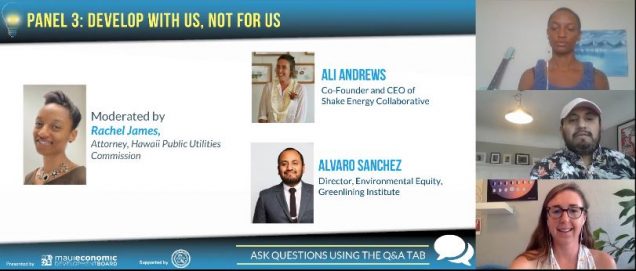
Moderated by: Rachel James, Attorney, Hawaii Public Utilities Commission
Ali Andrews, Co-Founder and CEO of Shake Energy Collaborative
Alvaro Sanchez, Director, Environmental Equity, Greenlining Institute
James commented, “At Hawaii Public Utilities, we work with investors contributing to electrification, who want to find partners in communities to advance those goals. We connect them, and help the community group design the project, and work with the utility to make a business plan. We are trying to make a policy package that works for everyone, to be inclusive to address the inequities in our society.”
James continued, “We must articulate the specific actions that the institution and its layers are going to commit to do over the course of the future to be able to address the inequities that happen in the bureaucracy system, so we are focusing a lot of our time on providing guidance and recommendations. For example, what are the specific things that you need to do in your planning processes, evaluation, and analysis to advance equity processes? We need to work with equity at the core, it has to be the approach; it has to be front and center.”
Andrews expressed, “We are now required to think deeply about engaging in communities. As a new developer, I am learning so much coming into partnerships with communities in disadvantaged neighborhoods. I am working with communities to see what they need to better inform the utility in terms of what they want developers to do. We need to develop with communities and not just for them.”
Andrews continued, “Financial and emotional ownership over the project is key. We are doing research to try to understand how we are successful or not in creating that sense of emotional ownership. Looking at shortcomings of residential solar policies and the cost, we should look more towards community scale projects, sharing, and co-ownership and build a shared project that fits the community.”
Sanchez emphasized, “I not only want a more green and cleaner future, I also want a more just and equitable one. For us, community is the ecosystem that is responsible for making a better world possible. We need to hear from them, learn their perspectives, and recognize their priorities. We must listen to the community to get a better understanding of their needs before planning. The government agencies, the utility, the business groups, the businesses all play a different role in the way that projects take place in community. Everyone has something to contribute. For us, the community is the most impacted, and they have the most at stake in whether or not the projects are going to be successful.”
Sanchez continued, “A lot of the focus in my work is on this and I think right now we are seeing the issues more pronounced. Covid-19 demonstrated all the inequities that are built into our system, showing that there is something at the root that creates disproportionate impacts for some populations versus others. Greenlining Institute has been focusing on the impacts. Race has always been an influence in who is successful and who is not in this country. That is really something that we need to understand when we are coming into communities with a fresh new perspective and a new project. That entire legacy cannot be undone immediately, but I think it is important for us to understand that people are struggling every day. We need to be open to what we propose.”
Sanchez concluded, “We need to do equity, but we have to understand where those communities are coming from in order for our message to be heard. Equity for me is not just about doing something better for me moving forward, it is about acknowledging the past, understanding the current conditions, and intentionally addressing those impacts. That to me is the equity that we have to implement in the work that we do in clean energy projects.”
PANEL 4: Leadership Toward a Just Grid
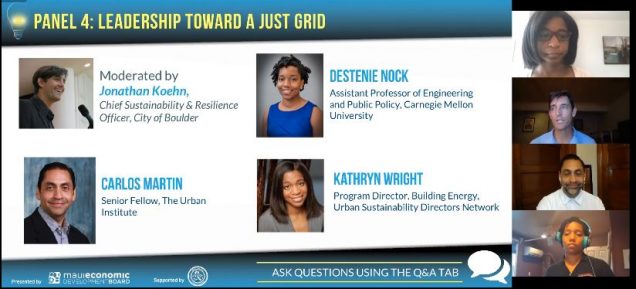
This panel discussed emerging efforts aimed at bending the arc toward vulnerable populations now, not as a last resort. The discussion was on the big opportunities that can arise from big issues. For example, how can we use the pain from the last few months to create a grid that works for more of society?
Moderated by: Jonathan Koehn, Chief Sustainability and Resilience Officer, City of Boulder
Carlos Martin, Senior Fellow, The Urban Institute
Destenie Nock, Assistant Professor of Engineering and Public Policy, Carnegie Mellon University
Kathryn Wright, Program Director, Building Energy, Urban Sustainability Directors Network
Koehn commented, “The clear message from today’s energy session is that to reach our clean-energy goals we really have to build and support solutions that truly include everyone. If nothing else, for me, 2020 has been a year of regaining perspective. There is a silver lining in times like these that makes us think of what matters most to us. I heard a determination today not to go back to normal because, even with the energy opportunities emerging, many are being left out. I have thought about the need to design a socially equitable and resilient energy system, and to have an economy that is built to last, and to fix inequities in our system.”
Wright pointed out, “Urban Sustainability has about 200 cities and counties across the U.S. and Canada including four in Hawaii, which are all working on the climate energy transition. Some of our research involves how Covid-19 is making the inequities in the energy system worse. One thing we have discovered is the relationship with energy burden, meaning how much of a household income goes towards paying utility bills? Currently, research shows that many people do not have emergency funds─ which is creating a lot of financial distress. In extreme heat season we are now seeing residential use has gone up for energy demand now that people are sheltering in place at home. There are additional energy burdens by communities already experiencing inequity. We are facing an intense challenge here. Some of our members are trying to attack this problem because they realize that even with the support that has been given towards moratoriums and disconnections, it simply is not enough to help people get through the process of sheltering in place, especially during extreme heat. This presents unique challenges that we are facing with the issues in our system.”
Wright continued, “In our equity research across the country, as well as in decarbonization, we learned it is especially important to put community at the very beginning of the process. Through our Zero Cities Project, a program supporting both cities and their most impacted communities to co-develop and implement actionable and equitable roadmaps and policy strategies to achieve zero net carbon, the building sector has spent a lot of time on what it means to transform a city environment. They are making sure that a lot of the neighborhood-based organizations and residences understand what the core issues are, so that they are able to prioritize. This plan gives the city responsive policy-making. I would say that any new policy has to start with community at the beginning and it involves a level of power-sharing and power-shifting that has not been a tradition of policy-making before in community engagement processes.”
Martin observed, “Community involvement is key no matter who the stakeholder is. The reality is that the utility burden is increasing in households today in the United States. Housing and residential segregation is something we also need to discuss. I measure inequity by housing situations, especially in energy performance. We need to look at all the inadequate housing in this country as problems we need to deal with.”
Martin added, “In my research, I look at the current state of measuring equity. It is about what the outcome is supposed to be and then how you align everything towards that process. Everything needs to be included: social aspects, social equity, and overall jobs. We look at different dimensions, understanding the historical legacies of disparities, and at energy jobs and energy options for long-term social economic outcome and equity.”
Nock asserted, “Thinking about energy burden, some of the people will not be able to take advantage of the programs offered. I am thinking as we are transitioning energy on the grid, the most important thing is not to have the energy burden increased as people are shifting to solar and wind. If they are jumping on and off the grid at a residential level somebody still has to pay for the reliability. The pole and wire prices do not change no matter how much electricity is used. Somebody still has to pay for them. We want to make sure that we are not transferring that burden of paying for the infrastructure side only to those who do not have the ability to jump off the grid.”
Nock continued, “I have been seeing inequities in my research on how our dependence on energy trickles down to the health impact of people. Communities are likely to live near power plants because land is cheaper, they are also less likely to adopt solar technologies because a lot are renter populations. People in high rise apartment structures also have limitations on the access to real solar technology so there are a lot of inequities there. Then we also have job inequities. In my group, we are talking about how we can make sure communities have access to jobs so that, when we are moving forward in energy transition, there is more access to renewable technologies, jobs, and solutions. Housing and quality of housing are key, and segregation patterns add yet another dimension into the picture.”
Nock reflected, “My work is focused on tradeoff analysis. One of the things we like to think about is what are the tradeoffs for different investments. Part of that is going into the community and talking to the stakeholders about what they want at the end of the day. There are always going to be tradeoffs, so we have to focus on a single best solution that is going to solve all of the problems. We have to have a deep understanding about stakeholder objectives and what we will agree or disagree on. This will help us understand the winners and losers of energy transition, and plan for the challenges that might arise, which will help the transition go more smoothly. With tradeoffs, you have to think about who are the winners and losers. We want policies that enable communities to develop local renewable energy generation and energy efficiency programs that help produce healthier neighborhoods, reduce the energy burden, and create good jobs for the local economy.”
CONCLUSION
The Hawaii Energy Conference serves to exchange ideas on how to better serve customers in a rapidly changing energy environment and discuss strategic developments in the policy, business, and technology of energy. This year’s conference focused on imagining a just and equitable recovery in the midst of a world changing event such as COVID-19. This unique opportinuity to hear from industry leaders and innovators attracted keen interest nationally and internationally. Attendees were able to network with each other through a conference browser app, and to access resources provided by sponsors through the virtual Exhibit Hall and digital swag bag.
Thank you to participating sponsors: Hawaii Clean Power Alliance, Hawaii Natural Energy Institute (HNEI), Ulupono Initiative, Hawaii Energy, Hawaiian Electric, Powin Energy, Progression Energy, 174 Power Global, Burns & McDonnell, Dudek, Elemental Accelerator, Greenlots, Kauai Island Utility Cooperative, OpusOne Solutions, Par Hawaii.


